Key takeaways
- Equipment certification is essential for ensuring reliability and legality in radio broadcasting, minimizing interference with other devices.
- Key equipment essentials include microphones, antennas, mixers, and processors, which collectively impact broadcast quality.
- Preparation for certification includes thorough pre-testing, meticulous documentation, and understanding certification standards to streamline the process.
- Staying organized, testing under varying conditions, and maintaining open communication with certifying bodies are crucial for a successful certification journey.
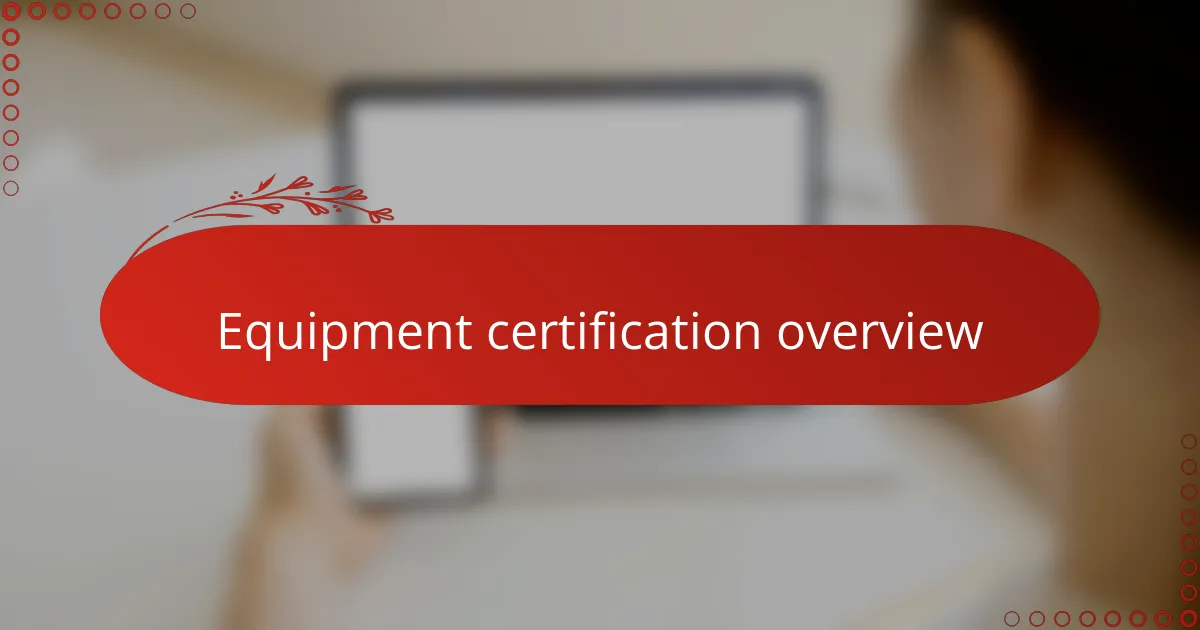
Equipment certification overview
Equipment certification is often the unsung hero in the world of radio broadcasting. I remember the first time I had to navigate through the maze of standards and regulations—it felt overwhelming, like decoding a secret language. But understanding this process is crucial because it ensures that our equipment performs reliably and safely.
Have you ever thought about what happens behind the scenes before a transmitter goes on air? Certification acts as that unseen checkpoint, confirming that all technical specifications are met and that interference with other devices is minimized. Without it, the quality and legality of broadcasts could easily be compromised.
From my experience, the moment equipment passes certification is a mix of relief and pride. It’s a tangible milestone that says, “This gear is ready for the demands of the airwaves.” That reassurance makes all the initial headaches worthwhile.
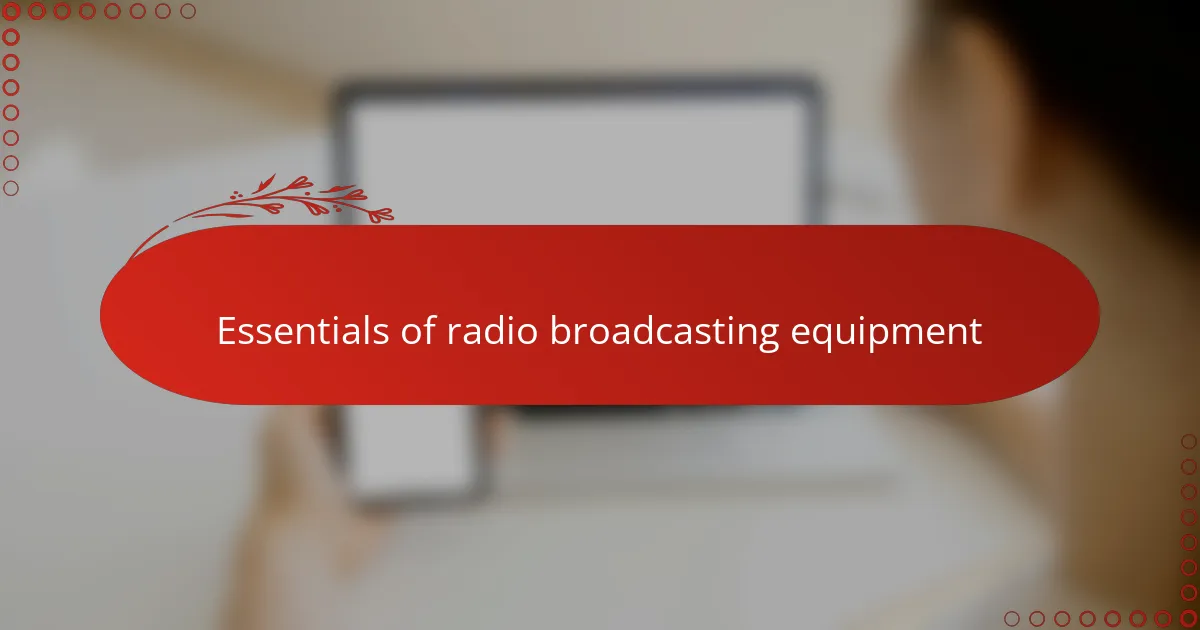
Essentials of radio broadcasting equipment
Radio broadcasting equipment revolves around a few key essentials that set the foundation for successful transmissions. From microphones capturing clear audio to transmitters pushing signals across the airwaves, each piece plays a vital role. I’ve found that overlooking any of these basics can instantly affect the entire broadcast’s quality—something I learned early on the hard way.
Have you noticed how a simple antenna can make or break your signal strength? That’s no coincidence. Antennas are the unsung heroes in my setup, tirelessly working to maintain a strong, stable connection. When I first upgraded to a higher-quality antenna, the difference was night and day—it felt like the station finally found its voice.
Equally important are mixers and processors, which shape and balance the sound before it reaches listeners. I got into trouble once by skimping on a decent audio processor; the result was a broadcast that sounded muddy and unprofessional. Investing in reliable gear isn’t just about equipment certification—it’s about respecting your audience and delivering a signal that stands out.
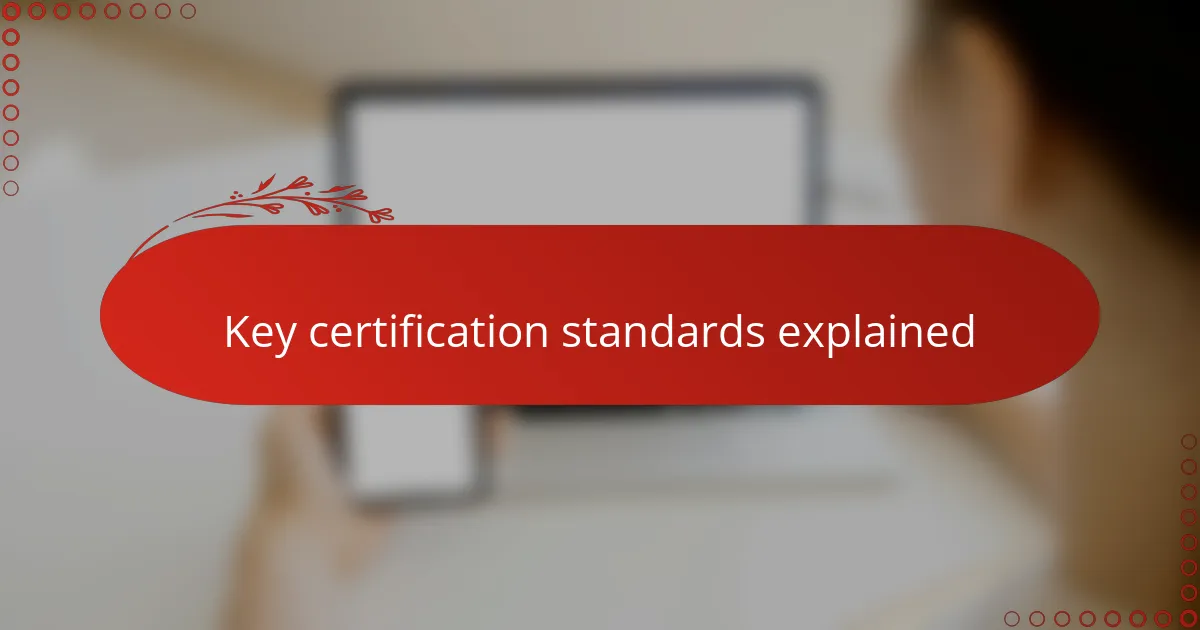
Key certification standards explained
Certification standards like the FCC Part 15 rules were the first ones I had to wrap my head around. At first, all those technical limits on emissions and interference felt like hurdles designed to trip me up. But soon, I realized they’re actually there to keep the airwaves clean and fair for everyone—a balance I came to deeply appreciate.
Another essential standard I encountered was the IEC 60268 series, which focuses on audio quality and safety for broadcasting equipment. When I learned how these standards guided everything from microphones to loudspeakers, it clicked why certified gear consistently delivers sound that feels professional and reliable. It was a game changer in my approach to choosing equipment.
Have you ever wondered why some transmitters just “play nice” with other devices while others cause chaos? That boils down to certifications like ETSI EN standards for electromagnetic compatibility. Once I understood how these rules minimize harmful interference, it was clear that certification isn’t just bureaucracy—it’s about respecting both your gear and your neighbors on the spectrum.
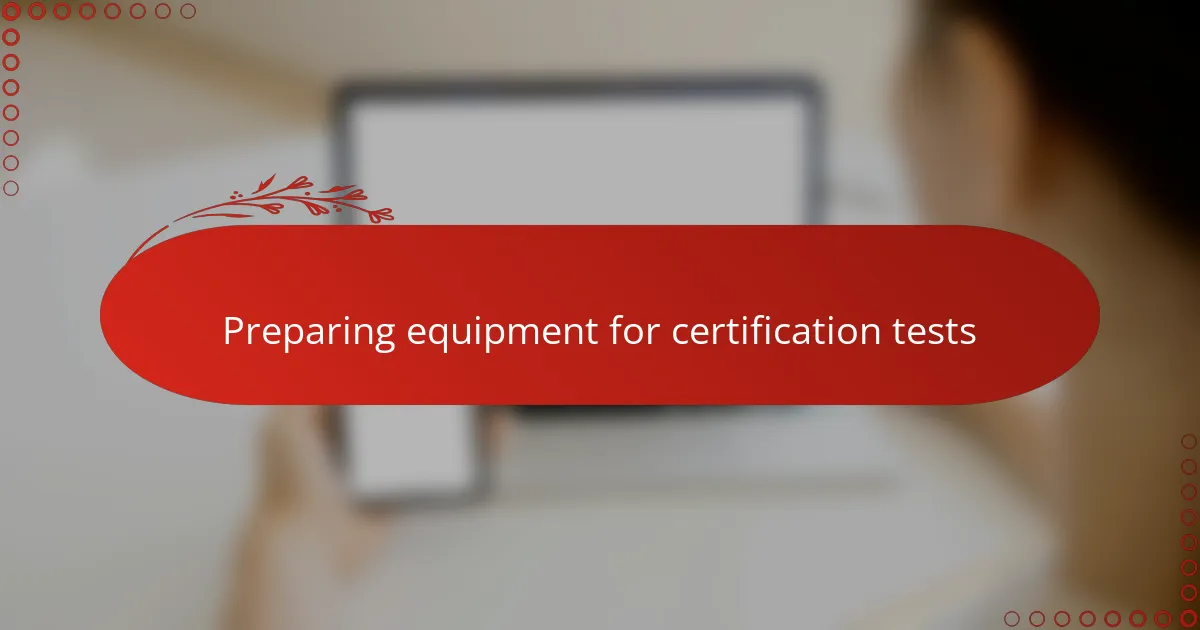
Preparing equipment for certification tests
Getting equipment ready for certification tests is a step I never take lightly. I always start by double-checking every connection and component to make sure nothing’s loose or out of place. It’s surprising how something as small as a frayed cable once caused me weeks of delay before I thought to look more closely.
Another thing I focus on is running thorough pre-tests under conditions that mimic real broadcasting scenarios. I ask myself, “Does this setup handle continuous use without overheating or signal drops?” When I saw my transmitter pass these internal tests smoothly for the first time, I felt a quiet confidence that made the official certification stage less intimidating.
Finally, documenting everything carefully is a habit I’ve developed over time. Every measurement, adjustment, and observation gets noted down because I’ve learned the hard way that detailed records can save hours of back-and-forth with testing labs. It’s like having a roadmap that guides you steadily through what can otherwise be a tricky process.
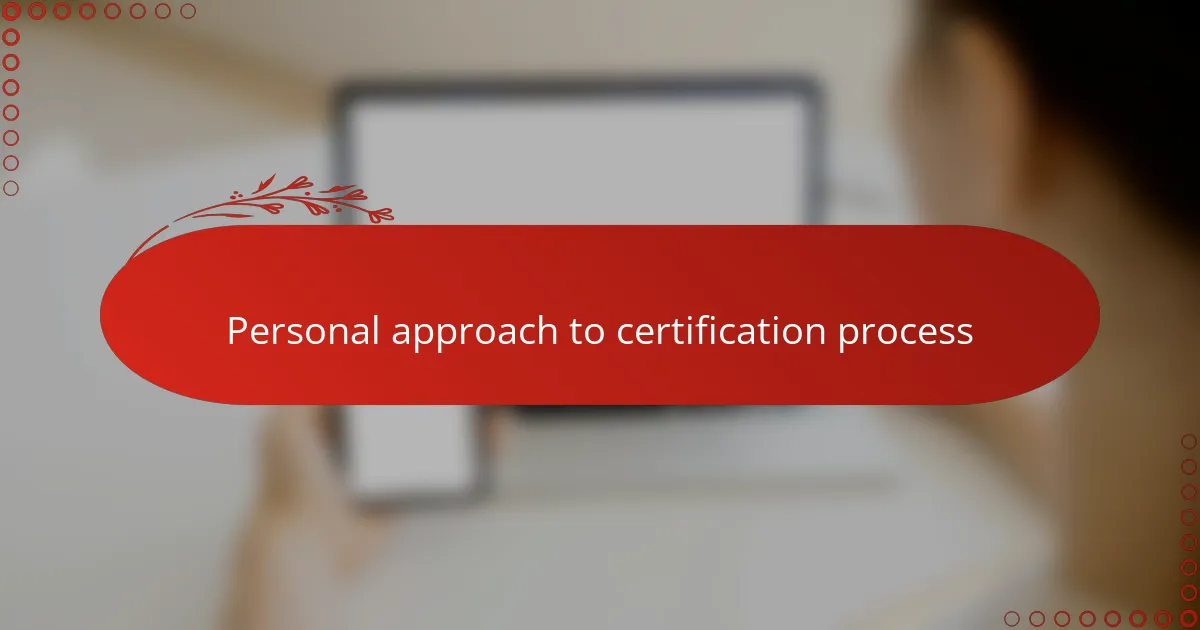
Personal approach to certification process
When I first approached the certification process, I treated it like a puzzle waiting to be solved rather than a tedious formality. I made it a point to immerse myself in the requirements, asking, “What exactly is this test looking for?” That mindset helped me stay curious and proactive, turning potential frustration into a learning experience.
Sometimes, the most frustrating part was waiting for results after submitting equipment. I remember feeling anxious, second-guessing if I’d missed something critical. But I learned to focus on what I could control—prepping thoroughly and trusting the process—because that patience paid off when the certification finally came through.
One habit that made a big difference for me was treating certification not as a single event, but as an ongoing conversation with the standards and labs. I reached out with questions, sought clarifications, and kept detailed notes. This approach didn’t just smooth the path; it made me feel more confident and empowered throughout the journey.

Challenges faced and solutions
One challenge that consistently caught me off guard was the unpredictability of electromagnetic interference during tests. I remember a case when my carefully calibrated transmitter suddenly failed due to unexpected noise from nearby equipment. It was frustrating, but it pushed me to rethink the layout and shielding in my setup, which ultimately led to a much cleaner signal.
Have you ever hit a wall waiting for certification results? That pause can feel like an eternity, filled with doubt and second-guessing. I found that staying proactive—double-checking every detail and keeping communication open with the lab—helped ease that tension and kept the process moving forward.
Documentation was another hurdle I faced. Early on, I underestimated how crucial meticulous records were, and that mistake cost me precious time when the lab asked for clarifications. Since then, I treat every note like gold, knowing that clear, organized information can be the difference between delays and a smooth certification journey.
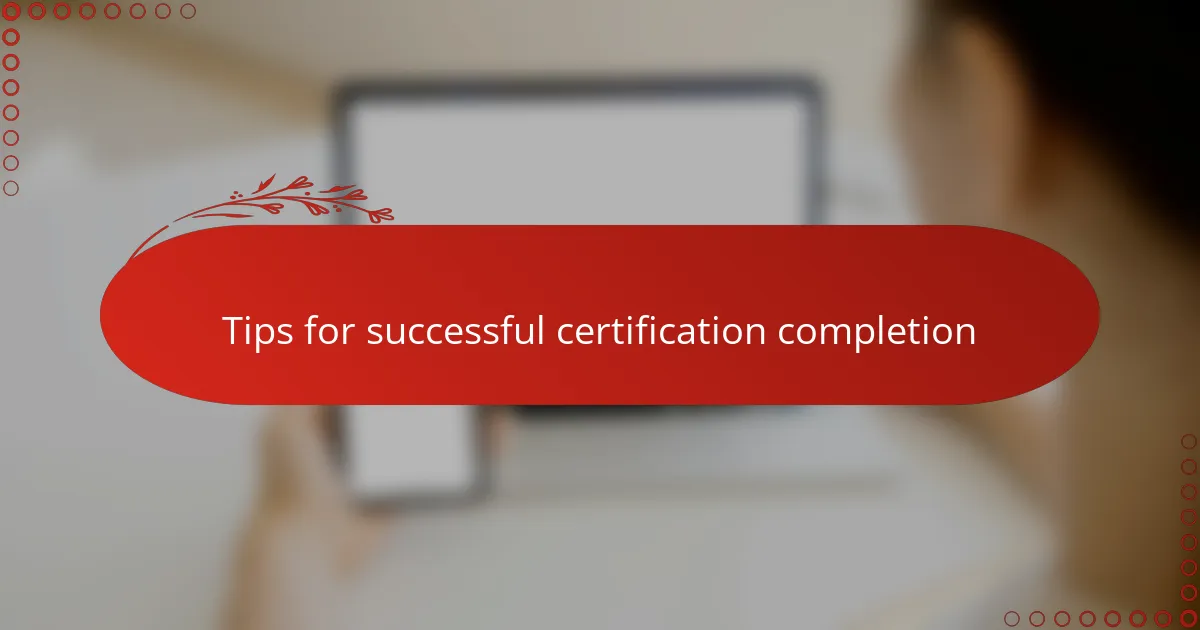
Tips for successful certification completion
One tip I swear by is staying organized right from the start. Have you ever found yourself scrambling for test reports or manuals at the last minute? That frantic search only adds stress. Keeping a dedicated folder with all your documents makes each step feel manageable, and honestly, it turned what could’ve been a headache into a straightforward routine for me.
Another thing I learned is to test under different conditions before submitting your equipment. I asked myself, “Will this gear hold up if the temperature spikes or the power fluctuates?” Running these checks helped me catch quirks early and saved me from costly retests later. It’s amazing how small tweaks can make a big difference in passing those stringent tests.
Lastly, don’t hesitate to ask questions. Early on, I was hesitant, thinking I should have all the answers, but reaching out to certifying bodies or fellow engineers opened doors I hadn’t considered. When I viewed certification as a dialogue rather than a hurdle, the whole process felt less intimidating and much more manageable. Have you tried that approach? It changed my perspective completely.
